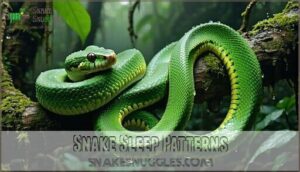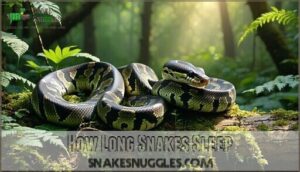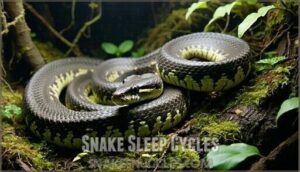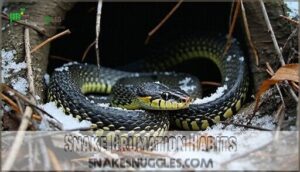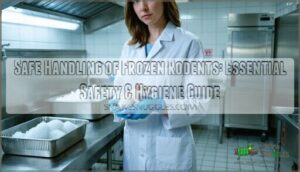This site is supported by our readers. We may earn a commission, at no cost to you, if you purchase through links.
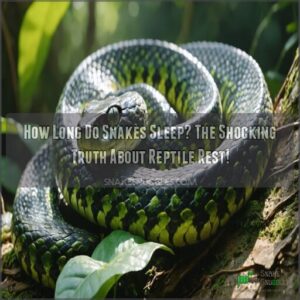 You’ll find that snakes sleep between 14-16 hours daily, though this varies widely by species.
You’ll find that snakes sleep between 14-16 hours daily, though this varies widely by species.
Unlike humans, snakes don’t have eyelids, so they’re never truly "lights out" when resting.
Their sleep patterns change with seasons—during winter, many species enter brumation, a reptilian version of hibernation where they’ll sleep for days or weeks at a time.
Temperature plays a pivotal role in how long do snakes sleep; warmer conditions typically mean less sleep while cooler weather increases their downtime.
The most fascinating part of snake sleep isn’t just its duration, but how their brains remain partially alert even at rest.
Table Of Contents
- Key Takeaways
- Snake Sleep Patterns
- How Long Snakes Sleep
- Snake Sleep Cycles
- Snake Brumation Habits
- Snake Sleep Physiology
- Frequently Asked Questions (FAQs)
- Do snakes wake up at night?
- How long do snakes sleep a day?
- How does lack of sleep affect handling snakes?
- How long should a person sleep for?
- How long do colubrid snakes sleep?
- Do Snakes Need to Close Their Eyes When They Sleep?
- Is There a Difference Between a Snake’s Sleeping and Hunting Behavior?
- How Long Can a Snake Stay Asleep?
- How Do Snakes Know Where to Sleep in the Winter?
- Does Brumation Affect Snakes’ Memories?
- Conclusion
Key Takeaways
- You’ll find that most snakes sleep between 16-20 hours daily, with some species like ball pythons sleeping up to 23 hours, and this duration increases after feeding to support digestion.
- Unlike mammals, snakes sleep with their eyes open since they lack eyelids, instead using specialized transparent scales called spectacles or brilles to protect their eyes while resting.
- Your snake’s sleep patterns will vary based on whether they’re diurnal, nocturnal, or crepuscular, with activity rhythms dictated by their species’ natural hunting behaviors.
- During winter, your snake will enter brumation (not true hibernation), where they remain in dens but may emerge on milder days, with their metabolism and heart rate significantly reduced to conserve energy.
Snake Sleep Patterns
You’ll find that snakes sleep for 16-20 hours daily, with patterns varying based on whether they’re diurnal, nocturnal, or crepuscular species.
Here’s a short, engaging blockquote about snake sleep patterns in the same informational tone:
Snakes slumber 16-20 hours daily, their rest patterns dictated by whether they’re day hunters, night prowlers, or twilight seekers.
While snakes might appear awake with their eyes open during rest, they’re actually using their retinas to block light as they cycle through slow-wave and REM sleep phases.
Diurnal and Nocturnal Behavior
You’ll notice distinct activity rhythms among snake species.
Some snakes are diurnal, hunting during daylight hours, while others are nocturnal, preferring the cover of darkness.
Certain species like corn snakes are crepuscular, most active during dawn and dusk.
These patterns affect snake sleeping habits and hunting strategies.
Their sensory adaptations, including specialized vision and heat-sensing pits, have evolved to match these activity periods.
Defensive snake postures are also influenced by these rhythms.
Seasonal shifts can also temporarily alter these natural behaviors.
Factors Influencing Sleep Duration
While some snakes are night owls and others early birds, several factors affect their sleep duration.
A snake’s genetic predisposition plays a key role, but environmental factors create daily variations too.
Food availability impacts rest—snakes sleep up to 20 hours after meals due to digestion intensity.
Environmental danger keeps them alert, while seasonal changes trigger adaptive sleep patterns.
Even subtle habitat shifts can dramatically alter a snake’s sleep schedule.
Brumation and Winter Sleep
During winter, your snake’s sleep habits dramatically change.
Winter transforms snake sleep patterns, shifting them into brumation—a fascinating energy-saving state with occasional basking on mild days.
Unlike true hibernation, snakes enter brumation—a state where they remain in winter dens but may emerge on mild days for basking behavior.
Rainfall effects can trigger activity even in cooler temperatures.
Snake brumation sleep isn’t continuous; they’re surprisingly alert and responsive.
Communal denning is common, especially in rattlesnakes, with multiple snakes sharing the same shelter.
Snake winter behavior varies widely between species and regions.
How Long Snakes Sleep
You’ll find that snakes typically sleep between 16 and 20 hours each day, with some species like ball pythons snoozing for up to 23 hours.
This extended rest period increases to about 20 hours after feeding, when snakes need extra energy to digest their meals properly, which is a critical aspect of their survival, emphasizing the importance of rest.
Average Sleep Duration
You might be surprised to learn that most snakes sleep between 16-20 hours daily.
This extensive snake sleep duration increases to around 20 hours post-feeding, when their bodies need extra energy for digestion.
During their waking hours, snakes are remarkably efficient:
- A ball python might appear frozen for days while actually conserving energy
- Corn snakes alternate between brief activity bursts and lengthy rest periods
- Wild species adjust their snake sleep patterns seasonally based on temperature and prey availability
These adaptations help snakes survive and thrive in their environments, making them fascinating creatures to study and learn about, with their unique ability to conserve energy through extensive rest.
Variations Among Species
The diverse world of snake species reveals striking differences in sleep habits.
Ball pythons snooze for an impressive 20-23 hours daily, while black mambas rest primarily at night.
Corn snakes follow a crepuscular pattern with two distinct sleep cycles.
These variations stem from habitat influence, diet impact, and size correlation.
You’ll find that terrestrial species often sleep on unstable perches, while others seek thorny plants for protection during their vulnerable rest periods.
Factors Affecting Sleep Length
Several factors impact how long your slithery friends sleep. After prey digestion, snakes often extend their sleep duration to 20 hours, conserving energy for the metabolic marathon.
Habitat safety plays a vital role too—snakes won’t rest deeply in exposed areas. Seasonal changes dramatically affect snake sleep patterns, with colder months triggering longer periods of inactivity.
Species variation and age influence also contribute substantially to diverse snake sleep behavior. Because snakes lack eyelids, they rely on spectacle eye protection during rest, which is crucial for their spectacle eye and overall metabolic marathon.
Snake Sleep Cycles
You’ll be surprised to learn that snakes experience both REM and slow-wave sleep cycles, much like you do when you’re catching Z’s at night.
Their brain activity slows during rest periods, with slow-wave sleep occurring in waves that total at least 16 hours daily, increasing to 20 hours after they’ve enjoyed a satisfying meal.
REM and Slow-Wave Sleep
You might be surprised to learn that snakes experience both REM and slow-wave sleep, similar to humans.
Recent studies on Australian bearded dragons suggest reptilian sleep includes two distinct sleep stages.
During REM sleep, snakes show increased brain activity with high-frequency patterns, while their slow-wave sleep features sporadic firing periods with short bursts of synchronized activity.
Unlike mammals though, a snake’s sleep cycle completes in just about 80 seconds, compared to our 60-90 minute cycles, which is a significant difference in sleep duration and pattern, highlighting the unique aspect of reptilian sleep.
Brain Wave Activity During Sleep
When scientists study snake sleep, they monitor brain wave activity through EEG measurements.
During slow-wave sleep, snakes display high amplitude waves (75-400 μV) at low frequencies (0.5-4 Hz).
Paradoxical sleep shows the opposite pattern with low voltage (5-10 μV) but high frequency (13-30 Hz) brainwaves.
Notably, reptile brainwaves sometimes show sleep-like patterns during wakefulness, and studies have found that atropine increases EEG spikes in some reptiles, suggesting unique snake sleep cycles.
Comparison to Mammalian Sleep
While brain wave patterns tell us about snake sleep states, comparing them to mammalian sleep reveals fascinating differences.
Unlike mammals with consistent REM and non-REM cycles, snake sleep cycles are less structured. Reptilian EEG readings show simpler sleep stages, with brain activity patterns that evolved differently over millions of years.
Because they lack eyelids, snakes rely on spectacle eye protection during sleep. You’ll find that evolutionary perspective critical – a snake’s sleep duration isn’t driven by the same complex neural mechanisms that regulate your own slumber.
Snake Brumation Habits
You’ll find your snakes entering a state called brumation during winter months, remaining in their dens but occasionally emerging to bask on mild days.
During this period, they’re not truly hibernating like mammals but instead maintaining a lower activity level while still responding to environmental stimuli such as temperature changes and rainfall.
Winter Denning Behavior
While snake sleep cycles follow fascinating patterns, their winter behavior is quite different.
During brumation (snake hibernation sleep), these reptiles carefully choose den sites that maintain steady temperatures.
You’ll find rattlesnakes in Arizona selecting rock piles or caves with specific entrance orientations.
Many species practice communal denning, sharing space with minimal territorial issues.
After rainfall, snakes might emerge briefly for winter hydration, even during cooler months.
Regional variations exist, with northern snakes typically experiencing longer brumation periods than their southern counterparts.
Temperature and Sunlight Effects
During brumation, temperature and sunlight play starring roles in determining a snake’s behavior.
You’ll notice these cold-blooded creatures respond dramatically to environmental cues, with den temperature serving as their primary alarm clock.
Snakes enter this energy-conserving state during colder months.
- Basking behavior increases when ambient temperatures reach 50-60°F, even in winter
- Rainfall influence can trigger emergence regardless of temperature
- Den temperature fluctuations of just 5°F can prompt movement
- Southern-facing dens receive more sunlight, affecting snake activity cycles
- Daily temperature variations impact how long snakes sleep during brumation
The factors influencing snake behavior during this period are multifaceted, including temperature fluctuations and sunlight exposure, which affect their activity patterns and sleep cycles.
Emergence From Brumation
While temperature and sunlight drive change, several factors trigger a snake’s emergence from brumation.
You’ll notice post-brumation behavior typically beginning when temperatures stabilize in early spring.
Rainfall’s influence can’t be underestimated—even during cooler periods, precipitation may prompt snakes to leave their carefully selected den sites for hydration.
Construction or landscaping near hibernation spots can cause disrupted brumation, forcing snakes to emerge prematurely.
Snake sleep duration during this period gradually decreases as activity levels rise.
Snake Sleep Physiology
You’ll notice significant changes in your snake’s body functions during sleep, with heart rate slowing to conserve energy and metabolism dropping by up to 70%.
Their eyes remain open while sleeping because they lack eyelids, instead using specialized retinas that block light and protect the eye surface, which is a unique adaptation to conserve energy and maintain metabolism.
Reduced Metabolism and Heart Rate
The remarkable ability to slow metabolism is one of a snake’s most impressive survival tricks.
During sleep, your slithery friends can reduce their metabolic rate by up to 70%, which directly affects their heart rate.
This energy conservation strategy allows snakes to survive long periods without food.
After eating, however, their heart rate spikes dramatically—up to 47 beats per minute—to support digestion.
Their oxygen consumption fluctuates based on activity levels and dormancy effects.
Eye Protection During Sleep
You might be surprised to learn that snakes sleep with their eyes open! Without eyelids, snakes rely on transparent scales called brilles (or spectacles) for eye protection during rest.
These specialized structures serve multiple functions:
- Maintain corneal hydration while preventing debris entry
- Filter light sensitivity during sleep periods
- Provide scale protection without compromising retina function
Their unique adaptations allow snakes to remain vigilant even when sleeping—a vital survival advantage in the wild, providing them with a vital edge.
Unique Sleep Adaptations in Snakes
While snakes protect their eyes with transparent scales, they’ve developed other fascinating sleep adaptations.
You’ll notice snakes can sleep in seemingly vulnerable positions thanks to their predator avoidance instincts.
Some species even rest on spiny plants for protection! Their circadian rhythms allow for open-eyed sleep using retinal light blocking.
During what appears to be foraging sleep, they remain aware of surroundings, adapting their snake sleep patterns to seasonal changes for survival.
Frequently Asked Questions (FAQs)
Do snakes wake up at night?
It depends on the species.
Some snakes are nocturnal and actively hunt at night, while others are diurnal (day-active) or crepuscular (active at dawn/dusk).
Their natural patterns determine when they’re awake, and this includes being nocturnal.
How long do snakes sleep a day?
Like tiny dragons in hibernation, your slithery friends snooze for 16-20 hours daily. You’ll notice this increases to about 20 hours after they’ve eaten, as digestion requires significant energy for them.
How does lack of sleep affect handling snakes?
When you’re tired, your reaction time slows and you’ll misjudge snake movements. You’re more likely to make handling errors that stress both you and your reptile, potentially leading to bites.
How long should a person sleep for?
Research confirms that you’ll function best with 7-9 hours of sleep nightly.
Your personal needs may vary by age and activity level.
Don’t skimp on rest – your body’s not running a marathon while you’re counting sheep!
How long do colubrid snakes sleep?
Colubrid snakes typically sleep 16-20 hours daily, with sleep duration increasing to 20+ hours after feeding.
You’ll notice they rest with eyes open, using their retinas to block light while maintaining environmental awareness.
Do Snakes Need to Close Their Eyes When They Sleep?
Snakes don’t close their eyes when sleeping because they lack eyelids.
Instead, they’re protected by a transparent scale called a spectacle.
You’ll notice they appear to be staring even while resting.
Is There a Difference Between a Snake’s Sleeping and Hunting Behavior?
You’ll notice dramatic differences between a snake’s sleeping and hunting behavior.
When hunting, they’re alert, tongue-flicking constantly to sense prey.
While sleeping, they’re motionless with reduced responsiveness, though their eyes remain open and they have a notable lack of responsiveness.
How Long Can a Snake Stay Asleep?
Most snakes can stay asleep for 16-20 hours daily, with some species like ball pythons sleeping up to 23 hours.
After feeding, their sleep may extend to conserve energy while digesting their meal.
How Do Snakes Know Where to Sleep in the Winter?
When winter approaches, your slithery neighbors sense dropping temperatures and changing daylight.
They’ll follow instincts to find dens with stable temperatures in rock piles, caves, or under structures that protect them during brumation.
Does Brumation Affect Snakes’ Memories?
Research suggests brumation doesn’t impair your snake’s memory.
During this winter dormancy, they’ll still recognize you when they emerge and can remember familiar territories, feeding spots, and even previous denning locations they’ve used successfully before.
Conclusion
Like a carefully tuned clock, a snake’s sleep cycle balances their survival needs with energy conservation.
Now you understand how long do snakes sleep—typically 14-16 hours daily—and why these patterns shift with seasons and temperature.
You’ve discovered their remarkable ability to rest with eyes open while remaining partially alert, and next time you spot a seemingly "sleeping" snake, you’ll appreciate the complex physiology behind their reptilian rest, which is a result of their unique sleep cycle that allows them to conserve energy and survive, making their sleep pattern a remarkable ability.

